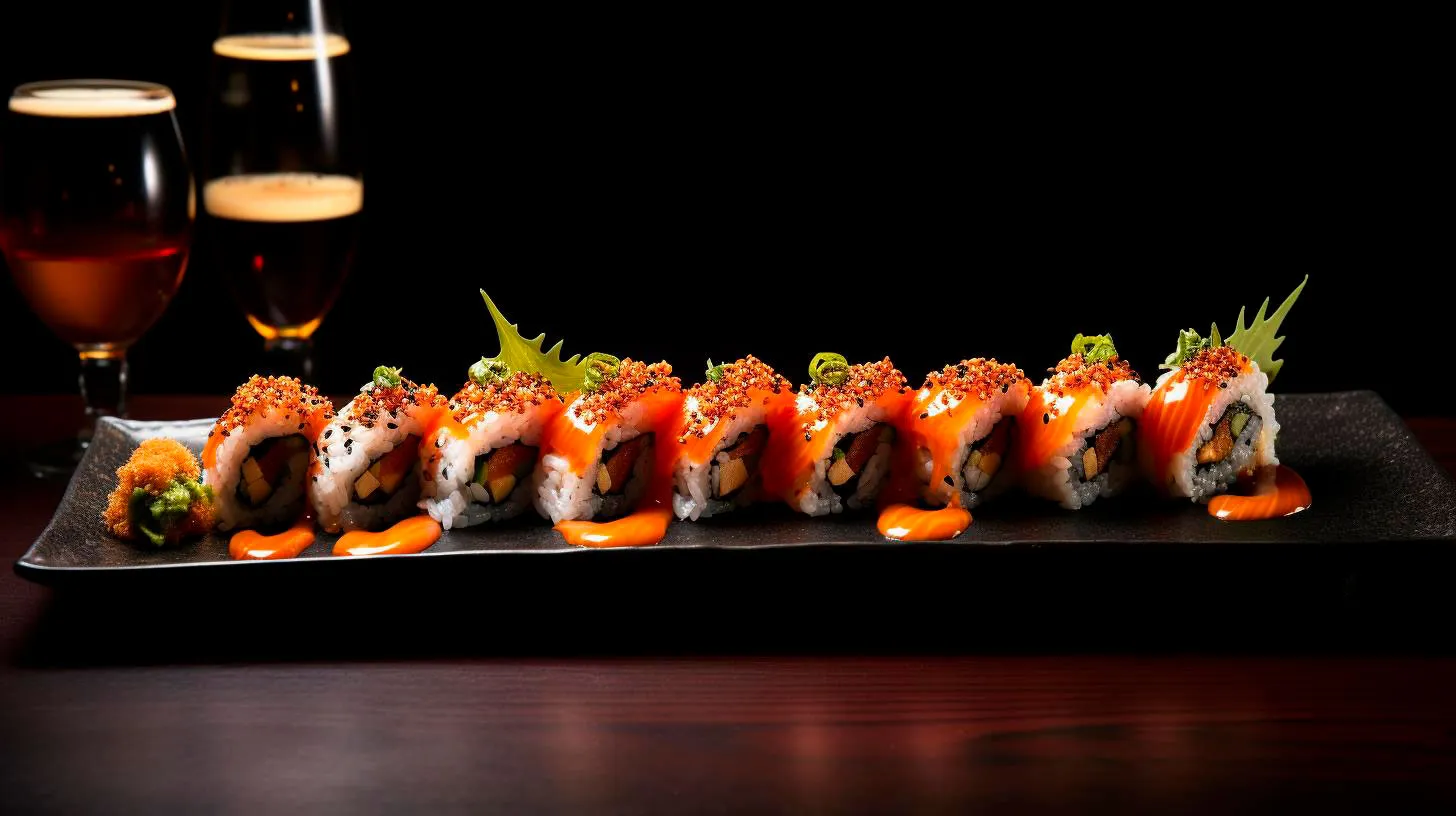Understanding Sushi Food Fraud Risks
It is essential for sushi lovers to understand these risks and how to identify potential fraud to ensure that they are getting the real deal. In this article, we will delve into the world of sushi food fraud, its consequences, and how you can protect yourself from falling prey to it.
The Risks of Sushi Food Fraud
Sushi food fraud is not a recent phenomenon but has been an ongoing issue affecting the sushi industry. The following are some of the risks associated with sushi food fraud:
- Health Concerns: Substituting low-quality fish in sushi dishes can have adverse health effects on consumers, especially if the substituted fish contains higher levels of mercury or other contaminants. This can lead to serious health conditions in the long run.
- Falsified Nutrition Information: By mislabeling fish, sushi fraudsters can also manipulate the nutritional information provided to consumers. This can be misleading, particularly for individuals who are mindful of their dietary requirements or allergies.
- Affordability Issues: Premium fish varieties used in sushi, such as bluefin tuna, are expensive. By substituting with cheaper alternatives, fraudulent individuals can increase their profit margins while deceiving uninformed customers.
- Environmental Impact: The mislabeling of fish contributes to overfishing and unsustainable practices. By purchasing mislabeled sushi, consumers indirectly support these harmful practices.
Identifying Sushi Food Fraud
To protect yourself from falling victim to sushi food fraud, it is important to be aware of common fraudulent practices and learn how to identify them. Here are some key indicators to look out for:
- Unusually Low Prices: If a sushi establishment is offering sushi dishes at significantly lower prices compared to others in the area, it could be a sign of fish substitution.
- Inconsistencies in Texture and Flavor: Different fish varieties have distinct textures and flavors. If you notice inconsistencies or an unfamiliar taste in a sushi dish, it may indicate that a fish substitution has occurred.
- Inaccurate Labels: Pay close attention to the labels on pre-packaged sushi or the menu descriptions. If the fish mentioned does not match the taste or texture, it is likely that fraud is taking place.
- Verify the Source: Whenever possible, inquire about the source of the fish used. Trusted sushi establishments are usually transparent about their suppliers, ensuring the authenticity of their ingredients.
Protecting Yourself from Sushi Food Fraud
While the risk of falling victim to sushi food fraud might seem disheartening, there are steps you can take to protect yourself and enjoy sushi with peace of mind:
- Choose Reputable Establishments: Opt for well-known sushi restaurants with a history of quality and authenticity. Look for customer reviews and ratings to ensure you are dining at a trusted establishment.
- Build a Relationship: Develop a rapport with sushi chefs or restaurant staff who can guide you in selecting the right dishes and provide assurance of the authenticity of the ingredients used.
- Stay Informed: Keep yourself updated with the latest industry news and stay informed about common sushi fraud practices. This knowledge will empower you to make informed decisions while enjoying sushi.
- Support Sustainable Practices: Choose sushi establishments that prioritize sustainability and responsibly sourced seafood. By doing so, you are not only protecting yourself but also supporting environmentally conscious businesses.
The Key Takeaways
Sushi food fraud is a concerning issue that compromises the quality, safety, and authenticity of this beloved cuisine. By understanding the risks, being vigilant when making dining choices, and supporting ethical establishments, consumers can help combat sushi food fraud. Remember these key takeaways:
- Food fraud in the sushi industry poses health risks and contributes to unsustainable practices.
- Identify fraud through low prices, inconsistencies in flavor and texture, and inaccurate labels.
- Protect yourself by choosing reputable establishments, building relationships with sushi experts, staying informed, and supporting sustainability.
By being aware and proactive, you can continue to enjoy sushi without compromising your health, taste experience, or support for sustainable practices.
Measures to Prevent Sushi Food Fraud
In recent years, cases of sushi food fraud have been reported, where inexpensive fish or substitutes were used instead of premium ingredients.
The Rising Concern of Sushi Food Fraud
Sushi food fraud is a significant concern for both consumers and sushi establishments. The deception revolves around misrepresenting the quality or type of fish used, which can have serious health implications for those with allergies or dietary restrictions. Additionally, it compromises the reputation of authentic sushi restaurants, leading to a loss of trust among customers.
Key Takeaways:
- Sushi food fraud involves substituting premium ingredients with cheaper alternatives, posing health risks and damaging reputation.
- Food fraud compromises authenticity and trust among customers, threatening the sushi industry.
Combatting Sushi Food Fraud
To protect consumers and maintain the integrity of the sushi industry, several measures have been developed to prevent sushi food fraud. These proactive steps include:
1. Supply Chain Transparency
One of the most crucial aspects in preventing sushi food fraud is ensuring supply chain transparency. Establishments should maintain direct relationships with trusted suppliers who source fish responsibly and provide detailed information about the origins and species of fish. Leveraging technology like blockchain can further enhance traceability by recording every step of the supply chain.
Key Takeaway: Establishments must prioritize transparency in their supply chains to ensure the authenticity of sushi ingredients.
2. DNA Testing
DNA testing has emerged as a reliable tool to verify the origin and species of fish used in sushi. By analyzing the DNA of the fish samples, it is possible to detect any adulteration and confirm the accuracy of labeling. Many sushi restaurants and seafood suppliers now employ this testing method to maintain the highest quality standards.
Key Takeaway: DNA testing helps identify any misrepresentation in the fish used and ensures adherence to quality standards.
3. Expert Training and Certifications
Enabling staff with comprehensive training on the different types of fish, their visual characteristics, and taste profiles is essential in combating sushi food fraud. Certification programs that test the knowledge and expertise of sushi chefs can help maintain a high level of authenticity. Equipping staff with the necessary skills ensures they can identify any inconsistencies and take corrective actions.
Key Takeaway: Expert training and certifications help sushi establishments identify fraudulent practices and maintain culinary excellence.
4. Consumer Awareness
Educating consumers about sushi food fraud and the importance of choosing reputable establishments can significantly reduce the risk. Encouraging individuals to ask questions about the sourcing practices and quality standards fosters transparency in the industry. Online platforms and review websites also play a pivotal role in sharing experiences and building trust among sushi enthusiasts.
Key Takeaway: Raising consumer awareness empowers individuals to make informed choices and create demand for authentic sushi.
The Importance of Preventing Sushi Food Fraud
Preventing sushi food fraud is vital to protect the health and trust of sushi enthusiasts globally. By implementing the measures outlined above, we can ensure that consumers enjoy the true flavors and experience of authentic sushi without any compromise. Maintaining the integrity of this culinary art form is not only a responsibility for sushi establishments but also for the entire industry.
As sushi continues to captivate palates around the world, combating food fraud is essential to safeguard the reputation and future growth of this beloved cuisine. Through supply chain transparency, DNA testing, expert training, and consumer awareness, we can collectively fight against sushi food fraud and preserve the authenticity of this culinary delight.
Key Takeaways:
- Preventing sushi food fraud protects the health of consumers and ensures the authenticity of this beloved cuisine.
- Supply chain transparency, DNA testing, expert training, and consumer awareness play crucial roles in combatting food fraud.
Addressing Sushi Food Fraud in the Industry
The sushi industry is facing a growing concern as some unscrupulous suppliers and restaurants engage in fraudulent practices that compromise the quality and authenticity of this beloved cuisine.
Understanding Sushi Food Fraud
Sushi food fraud refers to the deceptive practices within the sushi industry where mislabeling or substitution of fish and other ingredients occurs. This fraudulent activity can range from misrepresenting lower-quality fish as premium options to completely substituting one type of fish for another. Not only does this deceive customers, but it also poses potential health risks and undermines the sustainability efforts of the seafood industry.
The Impact on Customers and the Industry
Food fraud not only affects the consumer’s trust but also leaves a negative impact on the sushi industry as a whole. Some key consequences include:
- Customer Health Risks: Mislabeling and substitution practices can lead to customers unknowingly consuming allergenic or toxic fish species, resulting in potential health complications.
- Economic Losses: Fraudulent practices create an unfair advantage for dishonest businesses, undercutting honest sushi establishments and damaging the overall market.
- Environmental Damage: If lower-quality fish is mislabeled as a sustainable variant, it undermines efforts to protect endangered species and sustainable fishing practices.
- Loss of Customer Trust: Continuous food fraud erodes consumer confidence in the sushi industry, making customers skeptical about the quality and authenticity of the sushi they’re served.
Combating Sushi Food Fraud
Tackling sushi food fraud requires a collective effort from all stakeholders involved, including authorities, suppliers, and consumers. Here are some strategies to address this issue:
1. Strengthening Regulations and Oversight
Government bodies and industry associations should implement stricter regulations and standards to prevent food fraud in the sushi industry. This includes stringent labeling requirements, DNA testing of fish products, and penalties for offenders. Increased oversight and regular inspections can serve as deterrents to fraudulent activities.
2. Promoting Transparency and Traceability
Suppliers and restaurants should prioritize transparency in their supply chains, disclosing the origin of the fish they use and how it was caught. Implementing blockchain technology or other traceability systems can help ensure the authenticity of the fish and provide consumers with the necessary information to make informed choices about the sushi they consume.
3. Educating Consumers
Informing consumers about sushi food fraud is essential to empower them to make educated decisions. Educate customers about the variety of fish species used in sushi, their taste profiles, and the signs of potential mislabeling or substitution. Encourage customers to support establishments that prioritize transparency and sustainability.
4. Collaborative Efforts
Collaboration among stakeholders is crucial in combating sushi food fraud. Industry associations, suppliers, and restaurants should work together to establish best practices, share information, and report suspicious activities. Creating a strong network can help identify and address fraudulent practices more efficiently.
Key Takeaways
- Sushi food fraud is a concerning issue within the industry, involving mislabeling and substitution of fish and other ingredients.
- Food fraud poses health risks to customers, economic losses, and environmental damage.
- To combat sushi food fraud, regulations need to be strengthened, transparency and traceability should be prioritized, consumers need to be educated, and collaboration among stakeholders is crucial.
- By addressing sushi food fraud collectively, we can protect the integrity of this beloved cuisine and ensure the trust of sushi enthusiasts worldwide.
It’s time for the sushi industry to rise against food fraud and uphold the quality, authenticity, and sustainability that sushi represents. Together, we can preserve the legacy of this incredible cuisine for future generations.
Spotting Signs of Sushi Food Fraud
In this article, we will dive into the signs of sushi food fraud and how you can spot them.
1. Inconsistent Appearance
One of the first signs of sushi food fraud is the inconsistent appearance of the fish or seafood. Authentic sushi should always showcase fresh ingredients, vibrant colors, and an overall appetizing look. However, counterfeit sushi often uses subpar ingredients, which may appear dull, discolored, or even have a slightly off-putting smell. Paying attention to the appearance of your sushi can help you determine its authenticity.
2. Suspicious Texture
The texture of sushi is another clue when it comes to spotting food fraud. High-quality sushi should consist of fresh and tender fish or seafood, providing a delightful melt-in-your-mouth experience. If the sushi feels tough, chewy, or has a rubbery texture, it could indicate a lower grade of fish or even a substitution with a cheaper alternative.
3. Mislabeling of Ingredients
One of the most common forms of food fraud in the sushi industry is the mislabeling of ingredients. Sometimes, less expensive fish species are substituted for premium varieties but sold under the original labeled name. For instance, red snapper is a popular choice for sushi, but it is often substituted with less desirable fish that resembles it. Pay attention to the fish species mentioned on the menu and ensure that you are getting what you ordered.
4. Price Discrepancy
While premium sushi ingredients come with a higher price tag, excessively cheap sushi may be a red flag indicating food fraud. If a sushi dish appears to be extraordinarily inexpensive compared to other establishments, it is essential to question the quality and sourcing of the ingredients used. Remember that quality sushi requires fresh, high-grade ingredients, which come at a cost.
5. Origin and Sustainability
Knowing the origin and sustainability of the seafood used in your sushi is crucial not only for spotting food fraud but also for ethical consumption. Counterfeit sushi often uses illegally sourced or overfished species, contributing to environmental concerns and endangering marine life. Responsible sushi establishments will proudly share information about their sourcing practices and commitment to sustainability.
Key Takeaways
- Pay attention to the appearance and texture of the sushi to identify signs of food fraud.
- Mislabeling of ingredients is a common form of sushi food fraud, where lower quality substitutes are presented as premium options.
- Price discrepancies can indicate compromised quality, as high-grade ingredients come at a cost.
- Knowing the origin and sustainability of seafood used in sushi ensures responsible consumption and avoids supporting illegal fishing practices.
By staying vigilant and attentive to the signs of sushi food fraud, you can protect yourself from potential health risks and make informed decisions about where to enjoy this exquisite cuisine. Furthermore, supporting responsible and honest establishments contributes to the overall improvement of the sushi industry. So, the next time you indulge in a plate of sushi, remember to keep an eye out for these signs and enjoy your meal with confidence.



